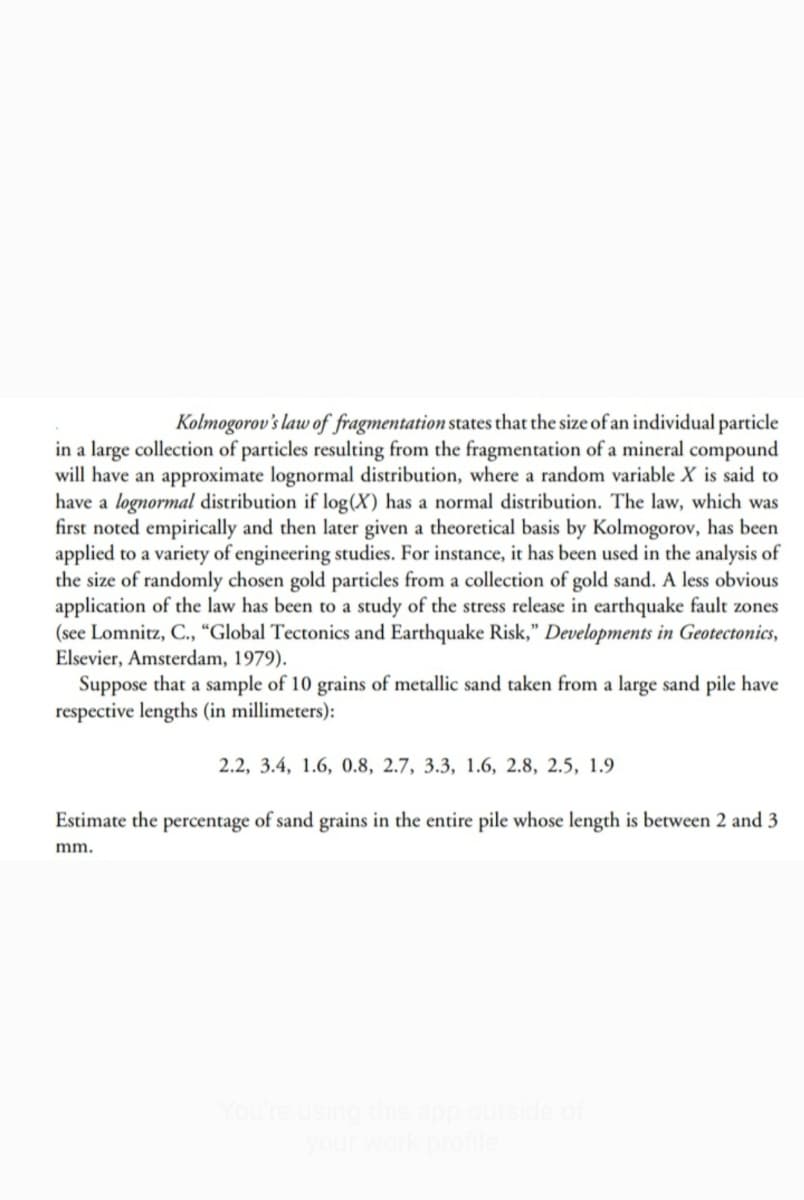Kolmogorov's law of fragmentation states that the size of an individual particle in a large collection of particles resulting from the fragmentation of a mineral compound will have an approximate lognormal distribution, where a random variable X is said to have a lognormal distribution if log(X) has a normal distribution. The law, which was first noted empirically and then later given a theoretical basis by Kolmogorov, has been applied to a variety of engineering studies. For instance, it has been used in the analysis of the size of randomly chosen gold particles from a collection of gold sand. A less obvious
Kolmogorov's law of fragmentation states that the size of an individual particle in a large collection of particles resulting from the fragmentation of a mineral compound will have an approximate lognormal distribution, where a random variable X is said to have a lognormal distribution if log(X) has a normal distribution. The law, which was first noted empirically and then later given a theoretical basis by Kolmogorov, has been applied to a variety of engineering studies. For instance, it has been used in the analysis of the size of randomly chosen gold particles from a collection of gold sand. A less obvious
Algebra & Trigonometry with Analytic Geometry
13th Edition
ISBN:9781133382119
Author:Swokowski
Publisher:Swokowski
Chapter5: Inverse, Exponential, And Logarithmic Functions
Section5.6: Exponential And Logarithmic Equations
Problem 69E
Related questions
Question
Parametric estimation

Transcribed Image Text:Kolmogorov's law of fragmentation states that the size of an individual particle
in a large collection of particles resulting from the fragmentation of a mineral compound
will have an approximate lognormal distribution, where a random variable X is said to
have a lognormal distribution if log(X) has a normal distribution. The law, which was
first noted empirically and then later given a theoretical basis by Kolmogorov, has been
applied to a variety of engineering studies. For instance, it has been used in the analysis of
the size of randomly chosen gold particles from a collection of gold sand. A less obvious
application of the law has been to a study of the stress release in earthquake fault zones
(see Lomnitz, C., “Global Tectonics and Earthquake Risk," Developments in Geotectonics,
Elsevier, Amsterdam, 1979).
Suppose that a sample of 10 grains of metallic sand taken from a large sand pile have
respective lengths (in millimeters):
2.2, 3.4, 1.6, 0.8, 2.7, 3.3, 1.6, 2.8, 2.5, 1.9
Estimate the percentage of sand grains in the entire pile whose length is between 2 and 3
mm.
fou
Expert Solution
This question has been solved!
Explore an expertly crafted, step-by-step solution for a thorough understanding of key concepts.
Step by step
Solved in 3 steps with 3 images

Recommended textbooks for you

Algebra & Trigonometry with Analytic Geometry
Algebra
ISBN:
9781133382119
Author:
Swokowski
Publisher:
Cengage

Glencoe Algebra 1, Student Edition, 9780079039897…
Algebra
ISBN:
9780079039897
Author:
Carter
Publisher:
McGraw Hill

Algebra & Trigonometry with Analytic Geometry
Algebra
ISBN:
9781133382119
Author:
Swokowski
Publisher:
Cengage

Glencoe Algebra 1, Student Edition, 9780079039897…
Algebra
ISBN:
9780079039897
Author:
Carter
Publisher:
McGraw Hill